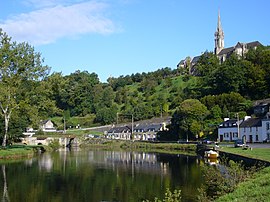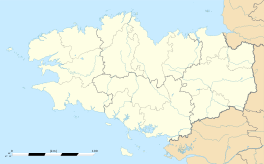Châteauneuf-du-Faou
|
Châteauneuf-du-Faou Kastell-Nevez-ar-Faou |
||
|---|---|---|
| Commune | ||

Châteauneuf-du-Faou on the Aulne and Canal de Nantes à Brest
|
||
|
||
| Coordinates: 48°11′15″N 3°48′47″W / 48.1875°N 3.8131°WCoordinates: 48°11′15″N 3°48′47″W / 48.1875°N 3.8131°W | ||
| Country | France | |
| Region | Brittany | |
| Department | Finistère | |
| Arrondissement | Châteaulin | |
| Canton | Briec | |
| Intercommunality | Haute Cornouaille | |
| Government | ||
| • Mayor (2014–2020) | Jean-Pierre Rolland | |
| Area1 | 42.58 km2 (16.44 sq mi) | |
| Population (2008)2 | 3,698 | |
| • Density | 87/km2 (220/sq mi) | |
| Time zone | CET (UTC+1) | |
| • Summer (DST) | CEST (UTC+2) | |
| INSEE/Postal code | 29027 /29520 | |
| Elevation | 31–153 m (102–502 ft) | |
|
1 French Land Register data, which excludes lakes, ponds, glaciers > 1 km² (0.386 sq mi or 247 acres) and river estuaries. 2Population without double counting: residents of multiple communes (e.g., students and military personnel) only counted once. |
||
1 French Land Register data, which excludes lakes, ponds, glaciers > 1 km² (0.386 sq mi or 247 acres) and river estuaries.
Châteauneuf-du-Faou (Breton: Kastell-Nevez-ar-Faou) is a commune in the Finistère department of Brittany in north-western France.
Châteauneuf-du-Faou is located in the middle of Brittany, between Monts d'Arrée and Montagne Noire. The town is built on a hill overlooking the Canal de Nantes à Brest, which is the canalized river Aulne. The bridge over this waterway was built in 1638, when Louis XIII was king of France, and is known as the "Old King's Bridge".
Châteauneuf-du-Faou is twinned with the English town of South Brent, and the Spanish town Chinchón.
The inhabitants of Châteauneuf-du-Faou are known in French as Châteauneuviens.
On November 6, 2006, the municipality launched a linguistic plan through Ya d'ar brezhoneg. In 2008, 10.4% of primary-school children in the area attended bilingual schools.
There is strong evidence that people have lived in this area for thousands of years. A large number of tumuli discovered near the sides of the road from Châteaulin to Carhaix testify to the density of the prehistoric population. Burial sites from the Bronze and Iron Ages have also been found.
Roman coins from the reigns of the emperors Gallienus and Aurelian were discovered in 1878.
...
Wikipedia



